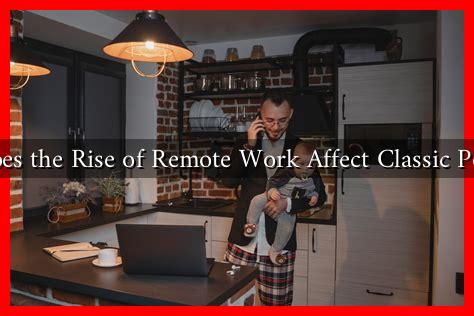-
Table of Contents
How Does the Rise of Remote Work Affect Classic Positions?
The COVID-19 pandemic has accelerated a trend that was already gaining momentum: the rise of remote work. As companies adapted to lockdowns and social distancing measures, many employees transitioned from traditional office settings to home offices. This shift has profound implications for classic positions across various industries. In this article, we will explore how remote work is reshaping job roles, altering workplace dynamics, and influencing employee expectations.
The Shift in Job Roles
Remote work has led to significant changes in job roles, particularly in classic positions that were once strictly office-based. Here are some key areas affected:
- Increased Flexibility: Many classic roles, such as administrative assistants and customer service representatives, have transitioned to remote formats. This flexibility allows employees to manage their time more effectively, leading to improved work-life balance.
- Technology Proficiency: Employees in traditional roles are now required to be more tech-savvy. Familiarity with collaboration tools like Zoom, Slack, and project management software has become essential.
- Redefining Productivity: The metrics for measuring productivity have evolved. Employers are now focusing on outcomes rather than hours spent in the office, which can lead to a more results-oriented work culture.
Impact on Workplace Dynamics
The dynamics of workplace relationships have also changed due to remote work. Classic positions that relied heavily on in-person interactions are adapting to new forms of communication:
- Collaboration Challenges: Teams that once thrived on face-to-face brainstorming sessions now face challenges in maintaining creativity and collaboration. Companies are investing in virtual team-building activities to foster connections.
- Management Styles: Managers are adapting their leadership styles to accommodate remote teams. This includes adopting a more empathetic approach and focusing on employee well-being.
- Onboarding Processes: The onboarding of new employees has transformed. Companies are developing comprehensive virtual onboarding programs to ensure that new hires feel integrated into the company culture.
Changing Employee Expectations
As remote work becomes more prevalent, employee expectations are shifting. Classic positions are now subject to new demands:
- Desire for Flexibility: Employees increasingly value flexibility in their work arrangements. Many are seeking positions that offer remote work options as a standard benefit.
- Work-Life Balance: The pandemic has heightened awareness of mental health and work-life balance. Employees are prioritizing jobs that allow them to maintain a healthy separation between work and personal life.
- Career Development Opportunities: Remote workers are looking for companies that provide opportunities for professional growth, even in a virtual environment. Organizations that invest in online training and development are more likely to attract top talent.
Case Studies and Statistics
Several companies have successfully navigated the transition to remote work, providing valuable insights into its impact on classic positions:
- Twitter: The social media giant announced that employees could work from home indefinitely. This decision has set a precedent for flexibility in the tech industry.
- Microsoft: A study conducted by Microsoft found that remote work led to a 20% increase in productivity among employees. This statistic highlights the potential benefits of remote work for classic positions.
- Buffer: Buffer’s annual State of Remote Work report revealed that 98% of remote workers want to continue working remotely for the rest of their careers, indicating a strong preference for this work model.
Conclusion
The rise of remote work is reshaping classic positions in profound ways. From redefining job roles and altering workplace dynamics to changing employee expectations, the impact is far-reaching. As organizations continue to adapt to this new normal, it is essential for both employers and employees to embrace the opportunities and challenges that remote work presents. By fostering a culture of flexibility, investing in technology, and prioritizing employee well-being, companies can thrive in this evolving landscape.
For further insights on remote work trends, you can explore resources from Gartner and Buffer.

